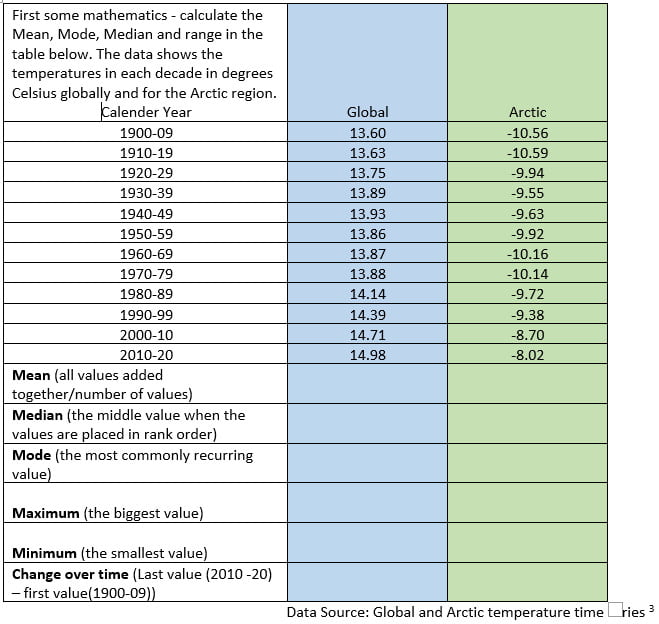Resources for OCR 2016 Geography B
We are delighted to have worked together with the OCR to develop resources to support this specification – click here to access the resources with links embedded into the scheme of work here.
Other Recommended Resources to Support the Teaching of Weather and Climate within this Specification
1.1
How can weather be hazardous?
a) Why do we have weather extremes?
- Outline of the global circulation system including the effects of high and low pressure belts in creating climatic zones.
- How the global circulation of the atmosphere causes extremes in weather conditions in different parts of the world.
- The extremes in weather conditions associated with wind, temperature and precipitation in contrasting countries.
- The distribution and frequency of tropical storms and drought, and whether these have changed over time.
- Outline the causes of the extreme weather conditions associated with tropical storms.
- Outline the causes of the extreme weather conditions of El Niño/La Niña leading to drought.
a) When does extreme weather become a hazard?
- Case studies of two contrasting natural weather hazard events arising from extreme weather conditions. The case studies must include a natural weather hazard from each bullet point below:
There must be one UK based and one non-UK based natural weather hazard event
- For each chosen hazard event, study the place specific causes (including the extreme weather conditions which led to the event), consequences of and responses to the hazard.
2.1
What evidence is there to suggest climate change is a natural process?
a) What evidence is there for climate change?
- The pattern of climate change from the beginning of the Quaternary period
to the present day. - The range and reliability of evidence relating to climate change including evidence from sea ice positions, ice cores, global temperature data, paintings and diaries.
b) Is climate change a natural process?
- Outline the causes of natural climate change including the theories of sun spots, volcanic eruptions and Milankovitch cycles.
- Investigate the natural greenhouse effect and the impacts that humans have on the atmosphere, including the enhanced greenhouse effect.
c) Why is climate change a global issue?
- Explore a range of social, economic and environmental impacts of climate change worldwide such as those resulting from sea level rise and extreme weather events. The impacts studied should relate to the 21st century.
- Explore a range of social, economic and environmental impacts of climate change within the UK such as the impact on weather patterns, seasonal changes and changes in industry. The impacts studied should relate to the 21st century.
4.2
Why should tropical rainforests matter to us?
a) What biodiversity exists in tropical rainforests?
- The distinctive characteristics of a tropical rainforest ecosystem, including the climate
4.3
Is there more to polar environments than ice?
a) What is it like in Antarctica and the Arctic?
- Outline the distinctive characteristics of Antarctica and the Arctic, including climate
7.1
How is the UK changing in the 21st century?
a) What does the UK look like in the 21st century?
- Overview of human and physical geographical characteristics of the UK, including population density, land use, rainfall and relief, and significant issues associated with these characteristics, including water stress and housing shortages.
8.1
Will we run out of natural resources?
a) How has increasing demand for resources affected our planet?
- Outline the factors leading to demand outstripping supply of food, energy and water.
8.2
Can we feed nine billion people by 2050?
a) What does it mean to be food secure?
- Understand the term ‘food security’ and the human and physical factors which influence this.
Some introductory ideas on Climate zones
Teaching Resources
Data and Image Sources
http://www.viewsoftheworld.net/wp-content/uploads/2014/12/AnnualPrecipitationAnimation.gif
ipcc-updates-geography-teachers/#9
Teaching Resources
Data and Image Sources
ipcc-updates-for-a-level-geography/security-of-water-supplies/
Teaching Resources
Data and Image Sources
Weather records will always be broken!
Further Information
In Depth – Extreme Weather (Met Office)
Teaching Resources
What do we mean by Extreme Weather? Data analysis.
Community experience of extreme weather Fieldwork/ investigation
https://www.rgs.org/schools/teaching-resources/key-stage-five/extreme-weather/
Work scheme on extreme weather including tropical storms
Data and Image Sources
Data and Image Sources
National River Flow Archive http://nrfa.ceh.ac.uk/
Current UK river levels http://www.gaugemap.co.uk/
Teaching Resources
Tropical Cyclones Scheme of Work.
Work scheme on extreme weather including tropical storms.
https://www.metlink.org/teachers/teacher-development/extreme-weather-2/
Data and Image Sources
https://www.metlink.org/other-weather/weather-hazards/drought/
Teaching Resources
Data and Image Sources
A case study of the 2003 heat wave.
A case study of the 2013 heat wave.
Teaching Resources
Data and Image Sources
Teaching Resources
Past Climate Change teaching resources
Data and Image Sources
Considerably more information can be found at our Climate Change Updates for Geography Teachers pages and in our general past climate change resources/ section.
Teaching Resources
Climate Change Schools Project
Data and Image Sources
UK climate projections and associated teaching resources
Further KS4 resources.
Link to OCR website for the full specification.



